Physical Address
304 North Cardinal St.
Dorchester Center, MA 02124
Physical Address
304 North Cardinal St.
Dorchester Center, MA 02124

Reading the comments or comments or God help you, takes it, if it’s forbidden, I’m curious to know how people were rating it. Songs of silence. The structure is very similar. Songs of victory Or heroes of power and/or magic, but with less RPG emphasis or base building, and less strategic combat.
Taxonomy is arbitrary and often not important at the end of the day, but I’m glad I bought it firmly into one category: not a bloody card game. Looks like one, sure. You do a lot of things with cards, and characters get more cards over time. But even if you absolutely, completely and utterly hate card-based systems, this game has none of that.
It’s about warlords dragging troops across an amazing top-down map, in turn, with grid-free movement, to destroy neutral armies and capture cities for XP and resources. Excellent, gold and army-enhancing artifacts arrive like precious trains that must be carried home after a battle accompanied by cash to prevent the enemy from capturing them. Components cannot be balanced, so losing them is no more painful than the cost of replacing them.
So how do you hire more classes? cards. How will you improve your settlements or use hero powers to install special buildings in them? Cards. How do you fight wars? Cards! I would have read this a month ago, and then for the next fifteen minutes I needed to take a deep breath with a suitable exhalation breath.
But it’s not a card game. Truly.
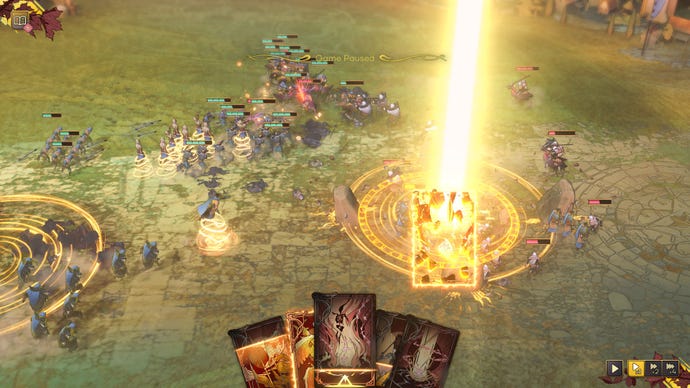
In recent years, there has been a trend towards not only dedicated deck builders but also card games into the square hole. The former is good. They are not my thing. I can hate people all I want without doing any harm to a completely valid thing that they clearly enjoy. I have even Recommended A a fewAnd only partially to use as a shield when you all say scary. The latter, although we’re sorry, is good and accurate. It’s how we discover new and strange things.
There is a third aspect of the card, however: a method of presenting information. I have translated it Shadow Empire Strategy cards as a way to represent the ideas of your advisors – each person is a file on your desk as if someone helpfully drew a little picture, because this would probably be appreciated by a dictator. The border of the star merchant colony It featured activities like cards such as scouting and exploration – each a possible outcome, which many character abilities could remove or replace to make your team appear to be affecting events. They did not collect cards, and they did not collect do anything. Counting these as “card games” is debatable. Whether it’s because I didn’t do it want Being them is also a less convincing argument.
With songs of silence, I go further: the cards are mere sentiment. Other than leveling heroes (choose one of 3 abilities) in a similar model, cards are not drawn, swapped, replaced, or discarded in any way. They are just UI. You can replace them with buttons MMO The action bars and the pattern will be the same. Somewhat better, in fact, because the cards actually get in the way, hiding each other from view, with beautiful illustrations that make it hard to tell which is which. To level a hero, the card appears on the map and you have to drag it to the hero’s model, which is probably a pointless chore I’m complaining about. Far from being a fairly minor criticism of this, I’m paying too much attention, but I don’t care. Cards must stand.
But I like silent songs. HoMM has a refreshing pace of destroying building sites and constant resource hovering. Surprisingly, however, it is replaced by an auto-fighter in turn-based tactics. “Combats are self-directed by a small player” is certainly not new – a moment’s thought goes to Settlers – but I had never really paid attention to it as a subgenre until SoS opened my mind to its potential to some extent.
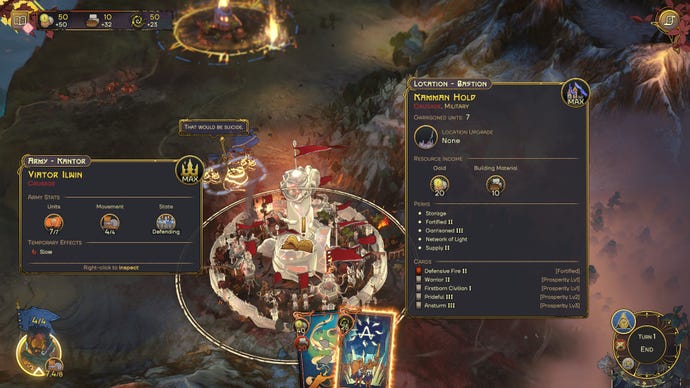
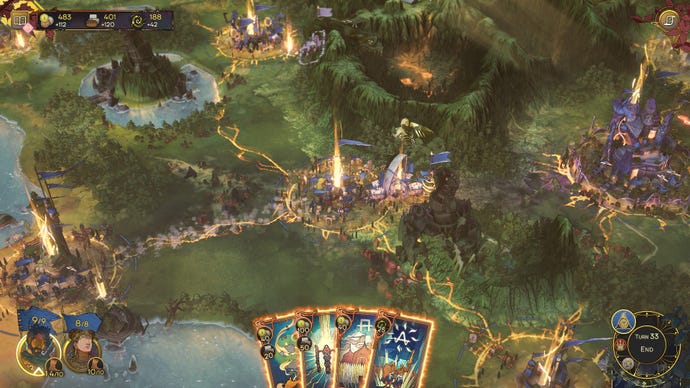
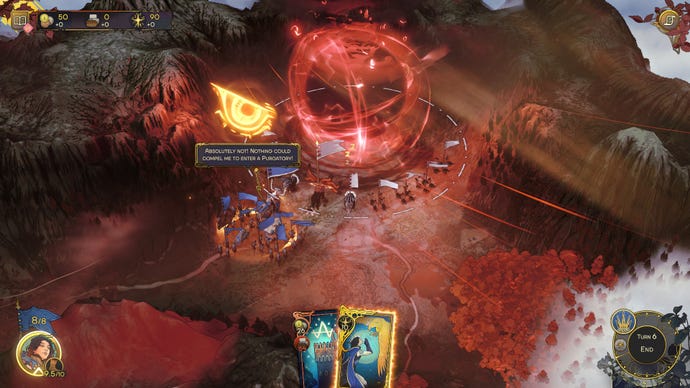
Enemy armies run into each other and exchange tense emails until one side dies or runs out for life. It simply takes a few minutes to watch, and periodically (hnngh) draw a card to destroy spells/powers that are constantly replenishing. There are none in Eagarlnia There’s showmanship, but there’s some showmanship (especially Vaad’s gang of villains), and plenty of detail as each squire runs around selfishly, magical cannons fire big-handed shots, and lancers swoop in on targets without delay and let the mobs spin. For another payment.
Some spells are frustrating, some improve the boring “+2 from +1”, and of course your anti-demon troops will eat your demon archers while targeting a squirrel. But that’s why you scout the enemy beforehand, and keep your troops simple-minded. The advantage is that you let go of the job of telling everyone what to do. Big matches don’t mean going back 80 decisions, or losing the battle because you clicked wrong seven mountains ago. Aside from constantly targeting and timing spells, your strategy is done, and it’s time to relax and see how you did.
There is no building to be demolished. Settlements grow automatically, leveling up if you extract the material. That includes production, and sometimes resources like healing or recruiting options. Each of them has a place for a special building, called by a hero without any conditions and research.
Armies are small, limited to seven reserves and healers recover very slowly. Units can’t be combined, and most consist of multiple little guys/ghosts/gubbins that reduce their damage proportionally. As a result, replenishing troops is everything. But recruiting is very slow, so you regularly visit your lands with heroes, or give one to a boat reinforcement. It’s a routine for cycling forces all around, made complex by formation importance, stacking bonuses, and enemy composition.
Each class has a number of qualities (what it is) and on top of that (what it does) such as flying, rejecting magic defenses, or dealing extra damage to enemies with a specific trait. Some give bonuses to the same allies: Hearthguard is very weak, but the trio more than doubles their strength. Add a unit and artifact that appeals to their qualities (Starborn, Infantry, Guardian) and they become a significant threat.
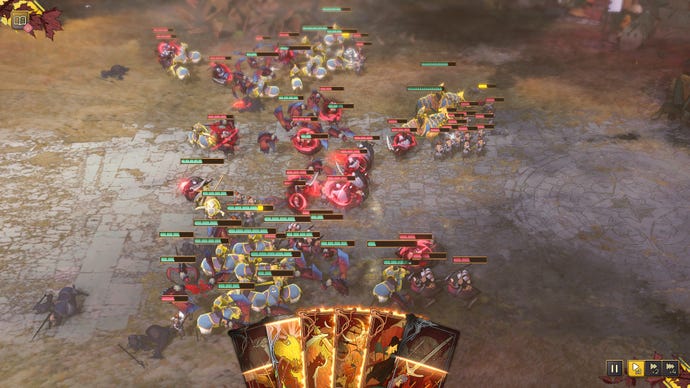
But wait. The enemy has anti-infantry and area attackers. I need to change the heart guards for the knights and put them in place. But if my other hero sits with the infantry, he loses movement, another of the city turns, if I hit him now, his backup will hit and I might lose that artifact….
All those decisions are the meat of the game, but they take more work than they’re worth, especially with so many unit types. There’s no way to tell what effect bonuses have on a unit (and morale is vague – many powers improve morale, but I don’t know what else it affects), getting information on enemies is a chore, some tooltips name powers but don’t explain them. There is too much reference, I was not helped by all the strange names (I was many hours before I was sure that the firstborn was the Primordialists from the particle introduction) and it is necessary to highlight each city to hire and hire. Can still rank.
I’m struggling with my aversion to the notification plague, so to speak, because SoS has the current fashion of drowning the screen in UI bullshit and notifications (who let the machines badger us? Why?) The moment they notify you, skip the class to comply with their company’s orders? But he could use some clear pointers on cities and battles. Its class panels are nice and stylishly arranged, but I have to hover over the rotation of icons one by one over and over again. Most of the time I can’t tell which units or soldiers are dead because everyone’s damage markers are yellow.
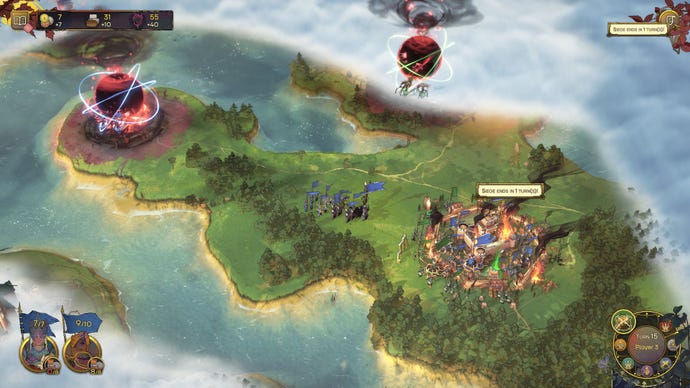
Despite a gorgeous and slick introduction, the campaign is a dull story without a single memorable character. Brawl offers the option to play on two maps simultaneously, connected by a portal. Some of these “purgatories” are the capital of a very interesting faction that moves them from city to city, consumes them for economic bonuses, and turns bodies into monsters or treasures in battle. The other two are dull in comparison, with different nomenclatures, but nothing dynamic.
Silent songs are amazing. Breaking with the established design framework was definitely a gamble that worked, creating its own comfortable and tiring model and incorporating car battles solved some of the fatigue and repetitiveness issues. Strategy games They fall into tactical combat. But its excellent art and an interesting faction underline the liminality of the rest of life, a clean story and two relatively pedestrian rivals. This design has legs, there are some interesting strategies here, and I hope a sequel or major expansion the studio can get to. But I certainly don’t expect it to be on the cards.